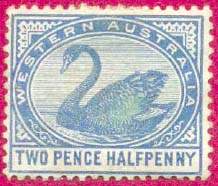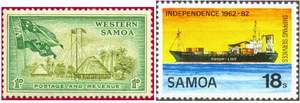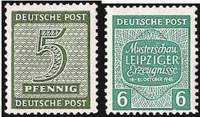WATERMARK SINGLE — view of the watermark pattern that is reproduced on paper postage stamps each sheet only 1 time and in full. Usually symmetrical pattern on the brand. Watermark single had the first postage stamps of Russia, 1858.
WATERMARK SINGLE — view of the watermark pattern that is reproduced on paper postage stamps each sheet only 1 time and in full. Usually symmetrical pattern on the brand. Watermark single had the first postage stamps of Russia, 1858.
VERTICAL WATERMARK — the watermark, the direction of rotation which is parallel to the sides of the brand. Postage stamps with a different direction of a picture watermark, for example, attachment of a sheet of paper in a printing machine of the other party, are varieties.
WAVE — philatelic the name of the picture watermark on the envelope paper used in issuing stamped envelopes of the USSR (standard art) in the years 1938-58.
The WAX — fat-like amorphous substance, sometimes used instead of wax for sealing letters. Found on some mail Domracheva period, and the 19th century.
WEAR the PRINTED FORM — the cause of certain varieties of postage stamps for mass printing of circulation or because of the fragility of the materials printed form. Wear the printed form affects the quality of printed impressions and leads to certain defects: nephropathia, smudging fine detail drawing extra strokes, dots, spots, separate potholes in clichés and more. Varieties as a consequence of Wear of the printing form — the special objects of philatelic collectibles. See the collection of research.
WEDGE PROVISORY (Moscow province) — a local issue of 1920, the revaluation of plying brands in the ratio 1:100, — manual overprint, the letters "R" and numbers a new par value of the postage stamps of Russia: the purple paint on stamps 1; 2; 3; 5 and 20 cents; red paint on stamps 2 and 10 cents; black paint on the stamp 20 cents.
Output INFORMATION — put in box vintage (post) sheet, and on the whole things information, about the printing enterprise, the name, the story of the brand or series, order number, date of printing, the artists and the engravers, the printing, circulation and so on. Particularly detailed Weekend information, there are, for example, on the issue of Bulgaria. Some output data are directly on the stamps. So, on stamps of the Soviet series "Russian folk tales and fairy-tale motifs" in 1969 and "the Art of Palekh", 1975, printed in the pilot order is not a factory of Goznak, Moscow and his printing press, before the notation of the year of issue is placed the abbreviation "MTG" (Moscow printing house of Goznak). On Soviet envelopes marked imprint placed on the back, and in unilateral commemorative and standard cards on the address side.

Output information on the marked postal cards of the USSR
WEIGHT FEE — additional fee for sending of the postal item weight, in excess of the established. Depends on the mass mailing. In the USSR, the Weight fee is charged for sending letters weighing more than 20, parcels — 50 g.
WENDEN MAIL [Lifland province, Russia, now the town of Cesis, Latssr]. In 1862 there was established district mail. The first stamp issued in January 1863. The inscription on the stamp (it.) "Vedenskaya the district mail". The stamps were produced until 1903. 1901 German inscription on stamps replaced by Russian "Vedenskaya County mail". The post office is closed 23.04.1903.

Brand Vedenskoi County mail
WEST BERLIN [West Berlin] — a special political entity in Europe, in the centre of the GDR. Status is governed by the quadripartite agreement of the USSR, USA, great Britain and France from 03.09.1971 and others. Since 1945 used stamps Main postal administration Berlin, and then the Control Council in Germany. In connection with a separate monetary reform in 1948, the Western powers issued their own stamps, in April 1949, the first commemorative stamps, in December 1949, the first block. Part of the issues (since 1959) repeated drawings of stamps of Germany. With 04.02.1950 3ападном in Berlin could be used stamps of Germany, and in Germany — brand 3ападного Berlin (with 20.01.1950). There were mixed tranceroute.
WESTERN CAMEROON [Cameroons] — former mandate territory administered by great Britain. Was part of Nigeria. In connection with the plebiscite on the nationality of the territory in October 1960, issued its own stamps — overprint (English) "Cameroon. Mandate territory of the United Kingdom" on stamps of Nigeria. According to the results of the plebiscite in the Northern part of the territory 01.10.1961 attached to Nigeria, and entered into circulation stamps of Nigeria. The southern part was ceded to Cameroon, and brand 3ападного of Cameroon was used to 30.04.1962, and then replaced by stamps of Cameroon.
WEST IRIAN (Irian Barat, Irian Jaya) [Irian Barat] — Western part of the island of New Guinea. A former colony of Netherlands New Guinea. With 01.05.1963 part of Indonesia. Since 1963 in the appeal of the brand to Indonesia with overprint (Indonesian) "West Irian" and released a commemorative series in honor of the reunion, as well as postage-due stamps. Production continued until 1970. The denominations in West iranskih rupees. After the introduction on the island Indonesian currency (in 1971) issue of own brands stopped.
WESTERN AUSTRALIA [Western Australia] — a British colony since 1831. With 01.01.1901 — state of the Commonwealth of Australia. Private stamps issued in the years 1854-1912. Almost all stamps depict the black Swan — the emblem of the colony (then state). In 1893-99 years as a mail used stamps. Released also 2 Telegraph stamps. In 1912 a large number of stamps 2 pence (1905) with overprint of new nominal value is used throughout Australia. All brands 3ападной Australia withdrawn from circulation 25.05.1913.

Stamp Western Australia
WESTERN HUNGARY RELEASES [Nyugatmagyarorszag]. After the 1st world war, the question of the nationality of territories with the centre in Sopron was to be decided by plebiscite. The Hungarian population, demanding the accession of Hungary, which revolted. The rebels released a series of 6 stamps with individual printings protective mats have, and in November 1921 — postage and postage-due stamps with original drawings. They sign (Hungarian) "Post Transleithania". Since 1922 used stamps of Hungary.
WESTERN SAMOA [Samoa i Sisifo] — Kingdom of the Islands of the Samoan archipelago in the Pacific ocean, built in 1899, the possession of Germany, in 1914 new Zealand troops occupied and since 1919 under the tutelage of New Zealand. Independence proclaimed 01.01.1962. Before 1914 used stamps German colonies Samoa. In 1914 issued stamps of New Zealand virgin Islands (British) "Samoa". In 1921, issued stamps with original patterns. In 1935 the country's name on stamps was changed to (English) "Western Samoa". In 1914-15 years was used fiscal stamps of New Zealand overprinted with the name of the territory. Brand independent gosudarstava began to produce in 1962, the first in 1969. In 1983 the name of the state changed to Samoa.

Postage stamps of Western Samoa
WEST SAXONY [Sachsen West] — a part of the Soviet zone of occupation of Germany with its centre in Leipzig (now part of Germany). After the defeat of Nazi Germany, postal Directorate in Leipzig was organized in September, 1945 issue of its own brands. They sign (German) "German mail". Released standard, post-charity and commemorative stamps in honor of the Leipzig trade fair and memorable unit. In 1946, entered into circulation stamps of the Control Council for Germany.

Postage stamps of West Saxony
WILENSKY MAIL — postal services, organized in 1667 between the Moscow and Vilna (in accordance with the Andrusovo truce with Poland). Was under L. P. and P. L. Marcelius, and 1675 — A. Vinnius. One of the first international routes in Russia with regular post office.
WILLIE, (Jean-Jacques Renouard de Villayer, 24.06.1607, Nantes — 05.03.1691, Paris) Jean-Jacques Renoir de (lived in the 17th century) — founder of the Paris city mail.
WINTERTHUR — the name of philatelic stamps of Switzerland 1850 intended for use in the postal district of Winterthur North of Zurich Canton.
Wire dot HOLE — stamp the name of the defect, postage stamps, a small through hole. Removed during restoration, such as completing a paper weight. Reduces the collectible value of the stamps.